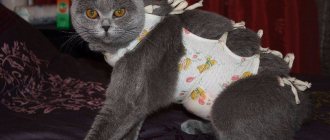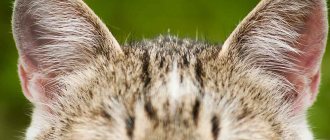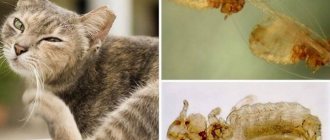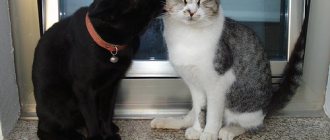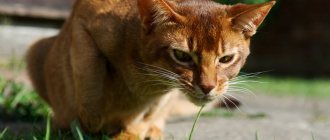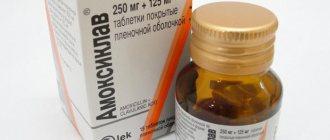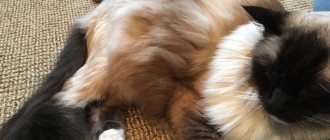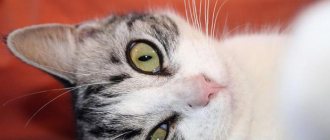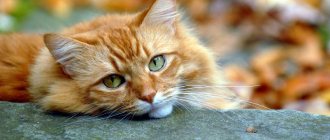Cat clothing is not a luxury, but a means to help short-haired and hairless domestic predators comfortably survive the cold season. If previously people would point a finger at an animal in an original costume, now times have changed, and fashion accessories can be bought in any store - regular or virtual. However, it is much more practical to make your pet happy if you make a piece of clothing with your own hands. This “adventure” will provide an opportunity to create a unique item that will be exactly the right size. In this case, they first select interesting models, clothing patterns for cats, think about suitable material, and how the wayward creature will react to the owner’s idea.
Idea for a simple DIY cat clothing pattern
This is the easiest DIY cat clothing option that does not require any special professional sewing skills. It’s easy to make such a sweater; you don’t need to go to a fabric boutique and buy material, you just need to take a large pant leg or sock. You don't need a pattern for this outfit.
Step 1. Take a blank - a trouser leg or a wide sock. Use chalk to measure the holes for the paws. Ready! All that remains is to cut out the holes using small scissors.
Step 2. To prevent the sleeves from looking untidy, carefully mark them with a needle and thread. The clothing does not require fastenings, jewelry or other accessories. You can safely put the jacket on your pet.
When developing a sketch or pattern, remember: it is necessary to arrange the parts in such a way that the cat has the opportunity to breathe freely and move confidently. Forget about sharp and piercing jewelry - the cat can remove, chew or accidentally swallow them.
Cute vest for a cat
To create this cat clothing pattern, you need to know the cat's neck circumference, back length, bottom circumference, and the length between the legs. If you want to use clasps, leave a small allowance for them.
Step 1. Mark the neck circumference measurement on a white sheet, but not with a straight line, but with a slightly rounded line. Exactly in the middle, draw a vertical line equal to the length along the back. The bottom part of the picture is the bottom of the product, its value is equal to the circumference of the cat’s lower body. Divide the “distance between the paws” parameter by 2, the resulting figure is the line to the beginning of the holes for the paws (on both sides of the vertical line). The dimensions of the vertical length of the vest depend on how long you want to give the product.
Step 2. Transfer the data to the selected fabric by attaching the pattern to it. Cut the resulting blank with scissors, then sew the product by connecting two opposite sides AB and CD. Cut out the piece, leaving a little space for the seam, then cut out the armhole for the paws, then hem or border the edges of the piece.
What outfits can we make?
Initially, it is worth deciding on the task that the clothing carries. What is it for?
- What to protect from the cold.
- For protection against insects and blood-sucking ticks.
- Due to the lack of hair, sphinxes can get burns on their skin; this breed should also be protected from the sun.
- For beauty. In a suit, the cat looks touching and stylish, and can become the hero of a party.
- To speed up shedding and protect furniture from fur.
- For medical purposes. Clothing covering post-operative sutures will prevent the animal from scratching or licking the wound.
- By covering the mother's nipples, you can wean the kitten off its mother's milk.
Pet stores offer clothing for small dogs as outfits for cats. Specialized cat tailoring is much scarcer than dog tailoring. Let's look at different types of outfits that you can make with your own hands, with examples of patterns for different clothes for cats.
Sweater
The sweater is easy to make and comfortable to wear. It can even be sewn from old clothes. For this you will need:
- Old jacket.
- Scissors.
- Measuring tape (meter).
- Lace for decoration.
All you need for the jacket is the sleeves. If the sweater is for a small kitten, use socks; the sewing technology is the same.
Iron the sleeve of the sweater and cut along the seam where the sleeve meets the body. You will need to measure the length of the cat along the back from the neck to the tail, then the sweater will cover the hips. The cat's neck will be in place of the wrist. Cut out the holes for the paws and the sweater is ready. If desired, you can decorate with lace or other decorations.
Sweater pattern. Bookmark the article so as not to lose it.
Sleeve sweater
You can sew a sweater not only from a sleeve. Watch the video, which describes in detail how to sew a sweater for a cat using the main part of a sweater.
Sweater from an old jacket
A knitted sweater looks special, cozy and beautiful. It fits well to the cat's body. Mostly suitable for sphinxes. If you're a beginner at knitting, a small cat sweater is a great way to practice.
When starting to knit, first measure the girth of the cat’s neck and length along the back from the withers to the tail. To make it you will need yarn, regular and circular knitting needles of the same thickness, thread and a needle.
Pattern for knitting a sweater
We knit in satin stitch. Cast on 25 loops and knit 3 cm, alternating knit and purl. Then we knit 10 cm in stockinette stitch. On both sides of the base we cast on 18 loops (61 in total). We knit 10 cm with facial loops. In the middle for the hole on the neck we close the loops (21 pcs.). Add another 28 closed loops and knit 10 cm. Close off 18 loops on both sides, and again 10 cm in satin stitch. We finish with an elastic band 3 cm wide, knitting it with the front and back through one. We close all the loops and assemble the product. Knit the collar as long as you wish with a 2/2 cm elastic band.
Knitted sweater for a cat
Dress
The easiest way to create a dress for a cat is to sew a skirt onto a sweater from the sleeves discussed in the previous example. You can also use a universal pattern that is suitable for any dress. Change only the material. If you don't make a skirt and make the main part longer, the pattern can be used as a pattern for a T-shirt for your cat.
Dress pattern
For a sundress dress, draw a pattern on the wrong side of the fabric. This should be done on ironed and folded fabric. You draw out half of the product, and when cutting it out you will get the whole product. It will then need to be sewn and the edges processed. The upper part of the product will be located on the cat's stomach. You can use the dimensions as in the picture with a margin and adjust them to the size of your cat after the first fitting. Don't forget to make allowances.
Sundress dress pattern
Sundress dress for a cat
Hoodie
To sew a warm sweatshirt for your kitten, take the necessary measurements. You need to measure the girth of the neck, the thickest part of the abdomen, the length along the back from the neck to the base of the tail. Record the circumference of the front legs and the width of the chest. If a hood is needed, also measure the length from the withers to the nose and the distance from the right side of the neck, passing through the entire head to the left side. For clarity, use a sweater pattern for your cat.
The fastening can be done both on the back and on the stomach. It's more comfortable on your stomach. With a fastener, add 2 cm on each side. Cut out the pattern pieces using seam allowances. Sew the hood along the line A1-A-A2. The neckline on the chest A-A2 can be made wider.
Sweatshirt pattern
Hoodie for a cat
Overalls
Jumpsuits are a great solution for walking on the street.
To sew, you will need to measure the waist circumference, the length from the neck to the tail, the distance from one paw to the other along the back. We prepare the fabric in accordance with the measurements taken. To ensure that the overalls are not too narrow given the smell, we make the width 2 cm larger.
Base for overalls
Cut holes for the front and back legs. We make the rear holes a little larger.
Holes for paws
Now you need to process the edges of the base. To ensure that the back of the product holds well and does not bulge, you can sew an elastic band along the back edge.
The overalls fasten at the stomach. For fastening, use buttons or a zipper, if desired. A hood wouldn't hurt a street jumpsuit. To make sleeves and pants, measure the diameters of the holes for the paws. We prepare the bases of the sleeves in accordance with the width measurements, length as desired.
Sew on sleeves and pants
For more information about the process of sewing overalls for a cat, watch the video.
Overalls for a cat, pattern example
Overalls for a cat
For this model you will need only one measurement - the length of the back (2 measurements, AB in the picture) Do not forget to try the product on the cat from time to time as you sew, adjusting the measurements to the width and length. Leave a little free space along the bottom of the legs into which to insert an elastic band.
Step 1. Draw a line on whatman paper equal to the length of the cat's back. Divide this value by eight - it will be the edge of the grid square on which you build your pattern. For example: the length of the animal’s back is 20, which means that squares must be built with sides of 2.5 centimeters. Outline the mesh, then carefully, according to the cells, transfer the outlines of the pattern from the drawing. The pattern should consist of several parts, the largest of which are the right and left sides, and the small one is a wedge that will be located on the chest and stomach (it must be sewn between the front legs).
Step 2. The overalls must be sewn in layers - for the upper part you can use low-maintenance raincoat fabric, for the lining take soft fleece or flannel. If you want, diversify the model with a hood - this will completely prevent your cat from getting wet when walking in the rain.
It is advisable to make the fastener on the upper back. This way the cat won’t be able to damage your hands when trying it on and won’t tear the zipper while wearing it.
Universal drawing
First, draw the back, which consists of two parts. In the middle is the fold line. The holes for the neck and legs are represented by semicircular notches. The length of the product is noted, and then a drawing is made using the data obtained. The CD line indicates the distance from the front to the hind legs.
A pattern made on the fabric will allow you to adjust all sizes during fitting. Your pet's clothing should be comfortable and not interfere with its movements. Therefore, 2 or 3 cm should be added to the girth measurements obtained. Up to 1 cm is added to the seams for oblique and curly cuts, and up to 2.5 cm for side and shoulder seams.
Comfortable and stylish pajamas
Cats are heat-loving animals, especially if you have a Sphynx living in your apartment. Pets with smooth coats require special attention, so comfortable pajamas are the ideal solution for caring for your four-legged animal. For this pattern of clothing for cats, any soft fabric, such as flannel, fleece or jersey, is suitable; it is better to use waterproof options. This option is printed on A4 sheets or applied independently to whatman paper.
Step 1. This model consists of several parts. Part 1 – back (GZ), the value is equal to the length of the cat’s back; you can also place a fastener along this line (for this you need to leave an allowance of two to three centimeters). Detail 2 (IZ) – belly measurement, folded along the IZ line.
Step 2. Place the pieces together and sew. The lines AG, BV, VD, DE are sewn together, the rest remain free (AB and EZh are the paws). The ZhZ line also needs to be sewn, but leave a small hole for the tail. When the work is ready, sew on a zipper if desired.
Some tips for sewing: make the seams overlap, using a zig-zag stitch, in this case they will be softer and will not disturb your cat. The lower edges of the paws and throat can be supplemented with a pre-prepared knitted ribbon. If the pajamas are made from fleece, the fabric does not need to be improved in this way.
Sweater for a cat
The Sphinx is an animal that has short hair, large ears like a bat, and is not always easy-going. But those who love this breed of cat know that they need to be kept warm at all times, because they are susceptible to cold. Therefore, it is necessary to insulate your pet if it is cold in the apartment or sometimes you take it out of the house. In this master class we will learn how to knit a cute sweater for your pet. For such a small product you will have to spend a little time, but then the cat or cat will be warm and will continue to delight the household for a long time.
Before we start knitting a sweater, we need to take measurements from the cat - length of the product, belly circumference, belly and back length, neck circumference.
Then we need to create patterns, which we can then use for further products for the cat. Knitting patterns are very simple, so even a novice needlewoman can handle it.
What we need to prepare:
- white wool mixture threads;
- red acrylic threads;
- knitting needles number 3;
- a needle with a large eye.
We start knitting from the collar. To do this, we put 71 buttonholes on the knitting needles with red threads and knit an elastic band, one front and one purl, to a height of seven centimeters. Now we divide the resulting fabric into two parts, where 25 buttonholes will be the stomach, and the remaining 46 will be the back. Now we switch to white threads and begin to knit with two balls, separately for the back and separately for the tummy.
1st row: belly - we knit all the buttonholes with knit stitches, while making 14 yarn overs evenly throughout the row. Back - we knit 23 buttonholes with knit stitches, then one yarn over and again with 23 knit stitches.
2nd row: we knit all the buttonholes purl on the back – that’s 47 stitches. Belly – 39 stitches are knitted with an elastic band one after another.
3rd row: tummy - remove the buttonhole, one yarn over, then again elastic 37 loops, and again yarn over and knit; back - remove, yarn over, knit 45, yarn over, knit. 4th row: back - purl everything; tummy - 41 buttonholes are knitted with an elastic band one after another. 5th row and 10th row: we knit the same way as the 3rd and 4th.
From the 11th row we begin to form armholes: tummy - close 3 buttonholes and knit 41 loops with an elastic band; back - close three buttonholes, purl the remaining 52 buttonholes. 12th row: back - close three buttonholes and purl the remaining 49; close three buttonholes, and then knit 41 loops with an elastic band. 13th row to 27th: we knit taking into account the pattern.
28th row: belly – you need to pick up three air stitches and then knit taking into account the pattern; back - three air and again taking into account the pattern.
Cute summer t-shirt
In the summer, a beautiful, stylish T-shirt will be ideal for your smooth-haired cat - but this model is most suitable for sphinxes, whose skin needs to be protected from direct sunlight. How to make a T-shirt for a cat with your own hands? First, prepare a light fabric, use knitted options. Draw the diagram yourself or print it out, cut it out and draw it onto fabric. Then proceed according to the instructions:
Step 1. As in the previous version, the GZ line is the length of the cat’s back. Fold the back (part 1) in two layers, cut it out, bending along the dotted line. Remember that the product should not interfere with the animal’s movement - if the cat is well-fed, make the pattern a little wider. Also cut out the belly (part 2) with a fold along the IZ line.
Step 2. Place the two parts together and sew along the lines BVD, AG. Use a zig zag stitch. Leave the lower part of the product, as well as the sleeves and neckline as is, but if necessary, the lower part and sleeves can be hemmed.
Let's move on to detailed tailoring for your beloved cat
To sew cat clothes we will use a universal pattern. It is suitable for a number of models: sweaters, overalls, dresses, etc.
If knitted items need a fastener, then when sewing you need to think about this detail. Lightning is contraindicated for ordinary cats, since the hairs get caught in a zigzag; in the case of the Sphynx, there is no such problem. But it will be more convenient to use velcro tape or buttons, and the latter will even serve as an excellent decoration. Velcro will allow you to quickly dress your pet. It is better to place the fasteners on the back so that they do not interfere with the cat.
A rustling material is not acceptable for use, as it will frighten the animal and will not want to wear this clothing.
Depending on the type of product, the sleeve may be shorter or completely absent.
You can also make holes in the hood for ears, it will be very cute.
Before cutting, be sure to try on the paper version and correct any inconsistencies so as not to spoil the fabric later.
Place the pattern on the laid out fabric with the wrong side up, carefully watch where the fold is needed, how many parts are required, trace it with chalk and cut it out.
We connect the side, shoulder, and sleeve seams, if any. We sew on a zipper or Velcro and begin processing the edges. The knitted fabric is twisted along the edge, it does not need to be edged, the rest is either folded and hemmed, or we use bias tape, this will look more aesthetically pleasing. Another interesting option is to crochet the edges of the neckline and sleeves.
Dress for a cat: we make an outfit with our own hands
To participate in exhibitions, tailed pets are well suited for a fashionable dress that can be created at home. This dress can be sewn using a standard pattern. Choose any soft-feeling fabric, the size of which should depend on the size of the cat itself.
Step 1. For the pattern you will need the length of the cat's back. Divide this parameter by ten - the resulting figure will be equal to the size of the cell. For example, with a back length of 20 centimeters, you will get a square with sides of 2 centimeters. Make a line on a piece of paper, place the sides and bottom there (as shown in the picture). Take into account all the edges and carefully count the number of squares so as not to make a mistake.
Step 2. You should have three parts - two sides and a bottom. Cut out the sides and bottom, then sew them together. The incision is present only on the upper part, which is located on the neck.
Step 3. Sew on a beautiful decorative button if you want to further decorate the dress.
Don't make the dress too tight, especially if the fabric is non-stretchy. Also, the animal may become confused in its movements if the dress is too loose. You should not think about making a dress that is too fluffy - such options are only suitable for holidays or exhibitions, during which the cat will not be able to move, but will sit in one place.
When making a holiday suit, you can sew it from a new beautiful fabric, and for daily wear you can use an outfit from old things. Your cat will find it easier to accept things that smell familiar.
How to sew a costume for a sphinx at home
You can make an outfit for your pet yourself. It will take a little longer, but it will allow you to realize all your fantasies and diversify your usual leisure time. The main advantages of making your own suits:
- Create a unique outfit. You can choose suitable materials for sewing and finishing, which will allow your Sphynx to be unique during a walk or exhibition.
- Cheapness. The price tag for cat costumes ranges from 600 to several thousand rubles: the cost of fabric and finishing materials will result in a much smaller amount.
- True to size. Since you will make the patterns yourself, the costume will suit your pet in all respects, because not every animal has the standard body length for which store-bought products are designed.
What materials and tools are needed to create cat clothes?
To make a costume for your pet, you will need to visit a fabric store or select old unwanted items that can be torn up and reused. Basic materials and tools include:
- sewing machine and overlocker (for processing knitwear);
- knitting needles, hook and yarn (if you plan to create a knitted product);
- threads (contrasting or in the color of the fabric);
- needles of various lengths and diameters;
- tailor's scissors;
- fabrics (inner lining);
- insulation (batting, synthetic winterizer, sherstepon);
- tracing paper;
- pattern;
- tape measure;
- zippers, buttons, Velcro or rivets;
- various decorative elements (lace, embroidery, fringe).
Photo gallery: necessary materials and tools for sewing
A sewing machine will simplify the sewing process Yarn is used to create knitted items
Synthetic winterizer can be used as insulation
How to take measurements of your pet correctly
Cats are very active and mobile animals that will not obey their owner and stand in one place for a long time. Therefore, to take the most accurate measurements, you will need not only a measuring tape, but also an assistant who will fix the sphinx. The animal must be placed on four paws while measurements are taken.
If your pet twitches strongly, you should check the accuracy of the measurements several times.
To prevent clothes from becoming too tight, take measurements within half an hour after feeding your Sphynx. What dimensions are needed to create a costume:
- Body length. It is measured from the bottom of the neck to the beginning of the tail.
- Neck length is measured when creating a collar for the product. It is measured from the base of the neck to the chin.
- Neck volume is measured at collar level. This size should be marked especially carefully so that the cat does not experience discomfort.
- The volume of the front legs is measured at their base, and the hind legs only need to be measured if you plan to create the bottom of the costume in the form of pants or shorts (at the level of the mid-thigh or the transition of the thigh to the foot).
- The volume of the torso in the axillary region is measured behind the cat's front legs.
- The volume of the body in the lower part is measured in front of the hind legs.
Where can I find patterns
Patterns for creating cat clothes can be found in specialized animal magazines or on the Internet. Many owners willingly post drawings of costume elements with a detailed description of how to correctly connect the elements of the product.
If you have certain artistic skills and imagination, you can come up with a pattern yourself.
Photo gallery: some popular patterns for creating clothes for sphinxes
Sweater - universal clothing for the sphinx
The overalls are perfect for a walk outside. The jacket can be worn on a cat in the cool season. A short blouse can become one of the elements of everyday clothing.
How to connect the parts of a suit together
You can sew clothing items together using a machine or by hand. To do this, you need to select threads that match the color and use small stitches to connect the parts of the costume to each other. Some elements of the product (hood, sleeves, stripes) can be removable: they can be secured with buttons, Velcro, snaps or zippers.
How to trim the edges of cat clothes
Processing is an extremely important step. It is this that gives the product a neat and finished look, and also allows you to avoid pulling out threads and damaging the suit. You can process the edges in the following ways:
- manually using contrasting threads;
- overcast using a machine (zigzag stitch, French seam);
- using an overlocker;
- using fabric glue;
- using adhesive web (special adhesive tape).
Photo gallery: how to process the edges of a product
Overlock processing gives the product a neat appearance
The French seam is almost invisible even from the inside Fabric glue firmly fixes the edges of the product
Adhesive web allows you to create a strong and invisible fixation
Various decorative elements
You can give your costume a festive look and make it unique with the help of various decorations. It is recommended to choose large decorative elements that cannot be accidentally torn off and swallowed by a cat (unlike rhinestones, beads, beads and sequins). You can liven up your outfit with the help of a variety of colors: a combination of two or more colors, or the use of melange yarn.
Items with various decorations are most often subject to hand washing: in the machine they can be damaged, which will lead to the product not looking right.
Other common decorative elements include:
- Embroidery. If you know how to do cross stitch or ribbon embroidery, you can add a beautiful design to your pet's costume.
- Lace, fringe and frills. These clothing items allow you to make your costume unconventional and eye-catching, and they are also easy to attach to any outfit.
- Stripes or transfer appliqués. They go well with knitted or cotton fabric.
- Drawings with acrylic paint. Such a decorative element will help turn even a simple product into a real work of art.
- Additional image details. A hat, socks, scarf or belt will make your pet look extremely funny and cute.
One of my friends took part in the exhibition along with her two sphinxes. She decided to sew memorable costumes for the pets that the judges would definitely like and leave a pleasant impression on the visitors. Since the exhibition was held on the eve of the New Year, the woman came up with images of Father Frost and the Snow Maiden for her pets, which she successfully brought to life. Partly thanks to these outfits, the cats took one of the first places in several categories.
Clothing patterns for cats: 5 important tips
- Try to accustom your animal to clothes from a very early age. Not all cats will be happy with a new piece of clothing - be patient to get your pet accustomed to the clothes. During fitting, reward your cat with affection and tasty treats, this will allow her to quickly get used to the new outfit.
- Make models on paper in real size - in this case, the parts can be easily attached to the fabric and made into a pattern.
- Accessories - all kinds of zippers, elastic bands and decorations are sewn on at the final stage of sewing, after trying on the animal.
- A cat cannot be dressed up every day, especially when it comes to clothes made of wool - it will start licking clothes, which can be harmful to health. Particularly sensitive pets may experience stress from being in unusual clothes for a long time.
- Do not force your cat to take part in taking measurements and trying on clothes - if she is not in the mood, you are unlikely to be able to create clothes that will suit your pet in all respects. Be patient and try to persuade the harmful pet to try it on next time.
Little orange sun 
Video “Clothes for cats”
This video shows how to sew a cute T-shirt for a cat with your own hands using a cat clothing pattern, and also gives useful practical tips for sewing it yourself.
Many owners from time to time dress up their beloved cats in a variety of cute and practical clothes. Cats in cool clothes are the new rage. You can create clothes for a cat yourself - it’s easy, interesting and doesn’t require financial expenses that hit your wallet. You can do this using your favorite clothing pattern for cats from the article.
Together with your pet, you can realize the most unusual ideas and ideas, and also turn creating clothes into a real hobby!
Cat size chart
To determine the size of the cat and select clothing, use the table below of standard sizes. You can also use it to determine the size of a small kitten. The table shows the average sizes of small, medium, large cats (L, M, S), and then each step changes by 3 - 5 cm.
Save the link to this article so as not to lose the cat size chart!
Cat size chart
For Sphynx cats, the sizes will be different, since Sphynx cats do not have hair.
Sphynx Size Chart
When purchasing clothes for a cat, we advise you to consult with the seller of the products or use the sizing instructions on the online store website.
